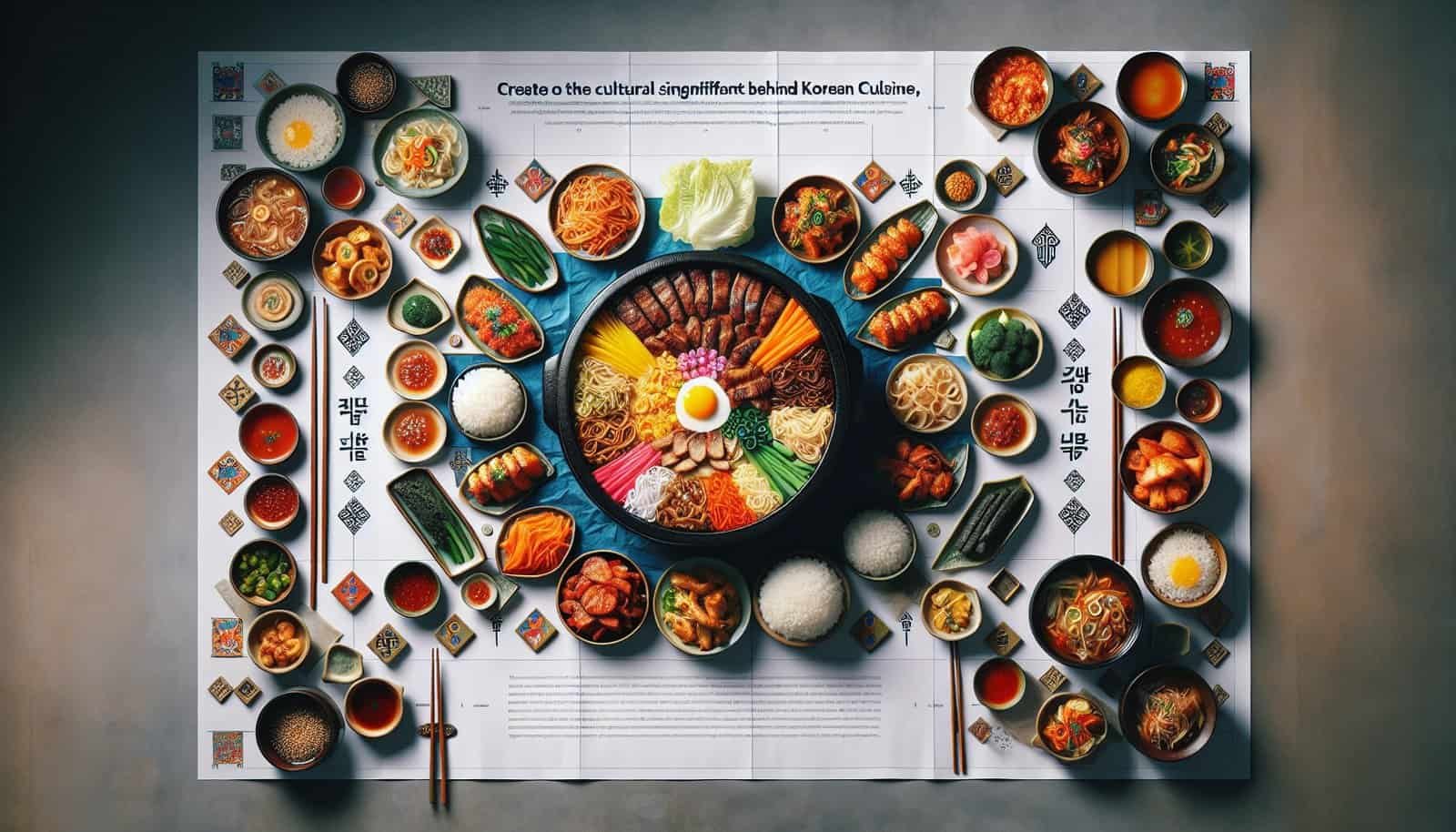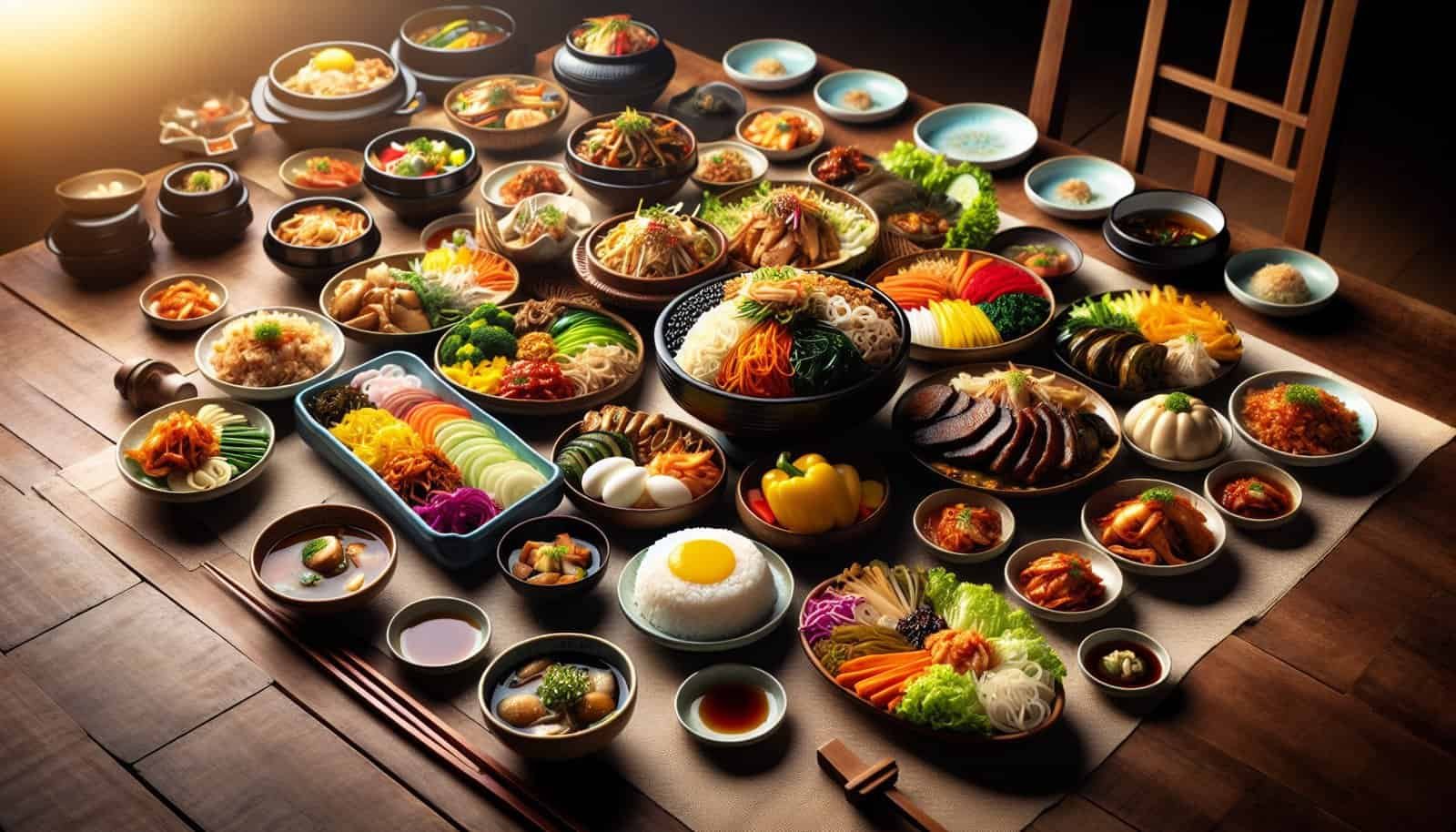Step into the vibrant world of Korean cuisine and uncover the hidden symbolism behind some of its most cherished dishes. From the fiery flavors of kimchi to the comforting warmth of bibimbap, each dish holds a deeper significance beyond its delicious taste. Embark on a journey of culinary discovery as we explore the cultural and historical significance woven into the fabric of these iconic Korean delicacies. Indulge your senses and learn about the intricate symbolism that adds an extra layer of fascination to Korean dining experiences.

Symbolic Meanings in Korean Cuisine
Introduction to the Symbolic Meanings in Korean Cuisine
Korean cuisine is not only known for its bold flavors and unique ingredients but also for its deep symbolic meanings. Many Korean dishes not only satisfy hunger but also serve as a vessel for expressing cultural beliefs and values. Each ingredient is carefully chosen to represent various aspects of Korean life, from family and traditions to health and vitality. In this article, we will explore the significance of some iconic Korean dishes and the symbolic meanings behind them.
Importance of Food in Korean Culture
In Korean culture, food holds significant importance beyond its sustenance value. It is believed that food not only nourishes the body but also the soul. From ancient times, the preparation and sharing of food have been seen as a way to connect with others and form strong bonds. Korean cuisine emphasizes communal eating and sharing, where families and friends gather around a table, enjoying meals together. This aspect of Korean food culture fosters a sense of unity and strengthens social relationships.
Role of Symbolism in Korean Dishes
Symbolism plays a crucial role in Korean dishes, adding a layer of meaning to the food experience. Various ingredients and cooking techniques are chosen not only for their taste but also for their symbolic representation of different aspects of life. This symbolism is deeply rooted in Korean history, cultural beliefs, and traditions. By understanding the symbolic meanings behind Korean dishes, we can gain deeper insight into Korean culture and appreciate the richness of its culinary heritage.
Bibimbap: Harmony and Balance
Overview of Bibimbap
One of the most popular Korean dishes known for its vibrant colors and diverse flavors is bibimbap. Bibimbap, which translates to “mixed rice,” is a bowl of steamed rice topped with various vegetables, meat, and a flavorful sauce. The ingredients are arranged beautifully on top of the rice, reflecting a harmony of colors and textures.
Symbolic Meanings of Ingredients in Bibimbap
Each ingredient in bibimbap holds a symbolic meaning. The colorful vegetables, such as carrots, spinach, and mushrooms, represent harmony and balance. The combination of different colors signifies the importance of diversity and how different elements can come together to create a harmonious whole.
Representation of Harmony and Balance
The arrangement of ingredients in bibimbap reflects the Korean philosophy of yin and yang, symbolizing the balance between contrasting forces. The balance between colors, flavors, and textures in bibimbap is not only visually pleasing but also demonstrates the importance of balance in life. Eating bibimbap is not only a culinary experience but also a reminder to seek harmony and balance in all aspects of life.
Hobakjuk: Symbol of Family and Traditions
Introduction to Hobakjuk
Hobakjuk is a traditional Korean porridge made from pumpkin. It is often consumed as a dessert or breakfast dish and holds great significance in Korean culture. The gentle flavors and creamy texture of hobakjuk make it a comforting and nourishing dish.
Symbolism of Pumpkins in Korean Culture
Pumpkins are highly regarded in Korean culture, symbolizing family, abundance, and harvest. The vibrant orange color of pumpkins is associated with happiness and good fortune. In Korean folklore, pumpkins are believed to ward off evil spirits and bring blessings to the home.
Connection to Family Values and Traditions
Hobakjuk’s connection to family values is deeply rooted in Korean traditions. It is commonly served during special occasions and family gatherings, signifying unity, love, and the importance of family ties. The act of preparing and sharing hobakjuk strengthens family bonds and creates lasting memories.
Japchae: Celebration and Longevity
Exploring Japchae
Japchae is a popular Korean dish made with glass noodles, vegetables, and often marinated meat. It is known for its vibrant colors and delicious flavors. Japchae is commonly enjoyed during celebrations and special occasions.
Symbolic Significance of Different Ingredients
Japchae represents celebration and longevity through its various ingredients. The long, chewy noodles symbolize long life, while the assortment of colorful vegetables signifies happiness and abundance. The addition of meat, such as beef or pork, represents prosperity and thriving livelihoods.
Representation of Celebration and Longevity
By serving japchae during important gatherings, Koreans celebrate milestones and wish for longevity and happiness for those present. The dish serves as a reminder to cherish joyful moments, appreciate the abundance in life, and strive for a long and prosperous future.

Samgyetang: Health and Vitality
Understanding Samgyetang
Samgyetang is a popular Korean soup made with a whole chicken stuffed with rice, garlic, and medicinal herbs. It is commonly consumed during the summer months as a way to replenish and restore energy. Samgyetang is known for its nourishing properties and is believed to boost overall health and vitality.
Symbolism of Chicken and Ginseng
The main ingredients of samgyetang, chicken, and ginseng, hold symbolic meanings. Chicken is associated with vitality, strength, and rejuvenation. Ginseng, often referred to as the “elixir of life,” is believed to enhance stamina and improve overall well-being.
Connection to Health and Vitality
The consumption of samgyetang reflects the Korean belief in the connection between food and health. Koreans view samgyetang as more than just a delicious meal; it is a remedy for fatigue and a way to improve one’s overall vitality. By consuming samgyetang, they embrace the idea of taking care of their health and ensuring a balanced and energetic life.
Tteokguk: New Beginnings
Overview of Tteokguk
Tteokguk is a traditional Korean soup made with sliced rice cakes and beef broth. It is a staple dish often enjoyed during the Lunar New Year celebrations. Tteokguk holds great significance as it symbolizes new beginnings and the transition into the new year.
Symbolic Meanings of Rice Cakes
The main ingredient of tteokguk, rice cakes, holds symbolic meaning related to the Lunar New Year. The cylindrical shape of the rice cakes represents the passing of time and the hope for a smooth and prosperous year ahead. Eating tteokguk is believed to bring good luck and drive away evil spirits.
Tradition of Eating Tteokguk on New Year
The tradition of eating tteokguk on New Year’s Day is deeply ingrained in Korean culture. It is believed that by consuming tteokguk, one becomes one year older and gains wisdom and blessings for the coming year. The act of preparing and sharing tteokguk during the Lunar New Year reinforces family bonds and celebrates new beginnings.

Mandu: Wealth and Prosperity
Introduction to Mandu
Mandu, Korean dumplings, are a beloved dish in Korean cuisine. They come in various shapes and sizes and can be filled with a variety of ingredients. Mandu is often enjoyed as a snack, appetizer, or a main course.
Symbolism of Dumplings in Korean Culture
Mandu holds symbolic meaning related to wealth and prosperity. The shape of mandu, resembling ancient Korean currency called “jeon,” represents fortune and abundance. Eating mandu is believed to bring wealth and financial success.
Association with Wealth and Prosperity
Mandu’s symbolism is deeply rooted in Korean cultural beliefs and traditions. During special occasions and holidays, families gather to make and eat mandu together, reinforcing the connection between food, unity, and prosperity. By enjoying mandu, Koreans express their desires for a prosperous and abundant life.
Kimchi: Fermented Tradition
Understanding Kimchi
Kimchi is undoubtedly one of the most iconic Korean dishes. It is a traditional side dish made from fermented vegetables, most commonly napa cabbage, radishes, and chili peppers. Kimchi is known for its spicy and tangy flavors and is a staple in Korean cuisine.
Symbolic Significance of Fermentation
The process of fermenting vegetables to make kimchi holds symbolic meaning in Korean culture. Fermentation is seen as a preservation method that allows food to be stored and consumed throughout the year, even during harsh winters when fresh produce is scarce. This symbolism reflects the resilience and adaptability of Korean people in the face of adversity.
Cultural and Historical Importance
Kimchi’s cultural and historical importance in Korea cannot be overlooked. It is often referred to as “kimjang kimchi,” signifying the communal effort of making kimchi together as a community. This tradition has been passed down for generations and represents the importance of cooperation, unity, and celebrating cultural heritage.

Gimbap: Tradition and Fortune
Exploring Gimbap
Gimbap, also known as kimbap, is a staple Korean dish consisting of seaweed-wrapped rice filled with various ingredients, such as vegetables, meat, and pickles. Gimbap is a popular on-the-go meal and is often enjoyed during picnics, family outings, and as a lunchbox option.
Symbolism of Ingredients in Gimbap
Gimbap holds symbolic meaning related to tradition and fortune. The combination of ingredients in gimbap varies, but each ingredient is carefully chosen for its representation of good luck and prosperity. For example, yellow pickled radish, a common ingredient, symbolizes wealth and good fortune.
Representation of Tradition and Fortune
Gimbap’s symbolism ties closely to Korean cultural traditions and beliefs. By consuming gimbap, Koreans honor their culinary heritage and express their desires for a fortunate and prosperous future. The portability and accessibility of gimbap make it a convenient symbol of tradition and fortune that can be enjoyed by all.
Jajangmyeon: Nostalgia and Resilience
Understanding Jajangmyeon
Jajangmyeon is a popular Korean-Chinese dish consisting of wheat noodles topped with a savory black bean sauce. It is a comfort food often enjoyed for its rich flavors. Jajangmyeon has a nostalgic appeal and holds symbolic meaning related to resilience and nostalgia.
Symbolism of Black Bean Sauce Noodles
The black bean sauce in jajangmyeon is what gives the dish its distinctive flavor and color. The dark, savory sauce represents the hardships and challenges faced in life. Eating jajangmyeon symbolizes the ability to overcome obstacles and find comfort in nostalgia.
Representation of Nostalgia and Resilience
Jajangmyeon holds sentimental value for many Koreans, evoking memories of childhood and the comforts of home. The act of enjoying jajangmyeon is a celebration of past experiences, reminding individuals of their inner strength and ability to persevere. In times of hardship, jajangmyeon serves as a reminder that resilience and fond memories can provide solace and strength.
In conclusion, Korean cuisine goes beyond satisfying hunger; it presents a rich tapestry of symbolic meanings and cultural beliefs through its diverse dishes. From the harmony and balance of bibimbap to the resilience and nostalgia of jajangmyeon, each dish tells a story, reflects Korean values, and celebrates different aspects of life. By understanding the symbolic meanings behind Korean dishes, we can appreciate the depth of Korean culture and the significance of its culinary traditions.

